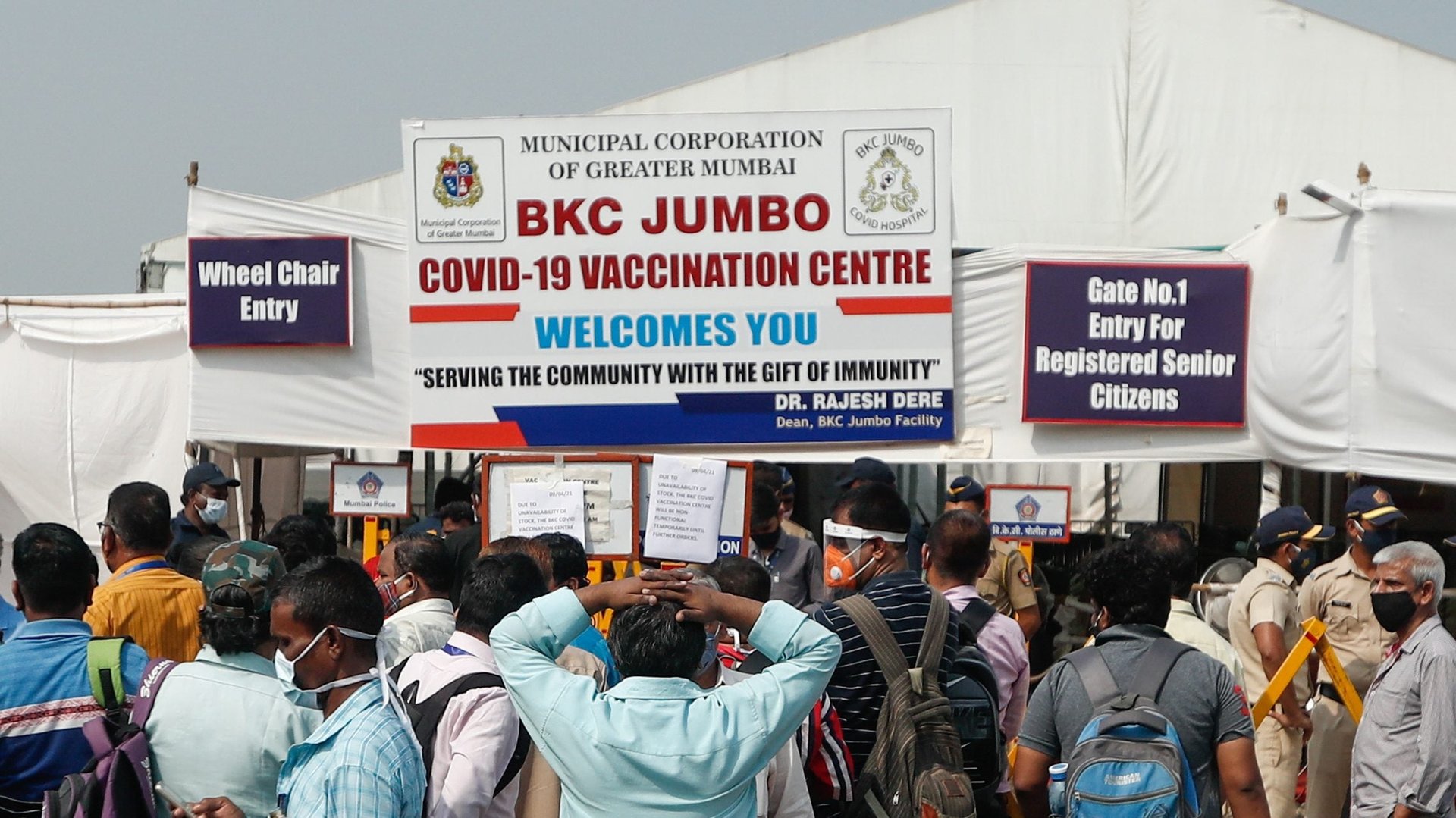India’s Covid-19 vaccination program is alarmingly behind schedule
India has administered over 158 million Covid-19 vaccine doses as of May 4, in a country of 1.4 billion people. With vaccination supplies dwindling, and delivery rates dropping however, the government’s goal to vaccinate 300 million Indians by August 2021 cannot possibly be realized.


India has administered over 158 million Covid-19 vaccine doses as of May 4, in a country of 1.4 billion people. With vaccination supplies dwindling, and delivery rates dropping however, the government’s goal to vaccinate 300 million Indians by August 2021 cannot possibly be realized.
Due to poor quality data, it’s difficult to predict when this milestone will be reached. In order to make a guess, a number of assumptions must be made. At the current rate of vaccine delivery, which dropped from 3.5 million a day in March to an average of 1.6 million daily doses this week, and assuming vaccine supplies keep up with that rate, it will take until February 2022 for the country to vaccinate 300 million people. And that’s still only 20% of the population.
India is administering Covishield—the local brand of AstraZeneca’s formula—and the made-in-India Covaxin vaccine. Both require two doses spaced four to eight weeks apart. The government’s language around vaccinations has been cleverly vague thus far, with some communiques indicating an intention to distribute 300 million doses by August. Other updates suggest 300 million people (600 million doses) will be fully vaccinated by then.
“We have a plan to give vaccines to 250-300 million people by July-August,” top health minister Harsh Vardhan has said. If that means 300 million doses—150 million people fully vaccinated—that’s more achievable. In the scenario outlined in the chart, the government could possibly reach that number by August.
Of course, there are a number of reasons to expect our simple projection to be entirely too optimistic. Maintaining the current rate of dosage delivery is highly unlikely as vaccine shortages grip the country.
The pace of Covid-19 vaccine delivery has slowed
On April 5, India hit an impressive vaccination peak of giving 4.5 million people shots in a day. By comparison, the US administered 3.4 million shots at its peak on April 13. However, the speed of vaccination has drastically slowed since then. Fewer than 1.5 million Indians received their first or second jab on May 4.
Supply constraints remain the biggest hindrance.
“India needs anywhere between 200 to 250 million doses a month to [support] Covid-19 vaccination drives to full capacity, and it has around 70-80 million doses a month. Clearly, there is a long way to get [to] that kind of supply,” Chandrakant Lahariya, a New Delhi-based doctor and a vaccines, public policy, and health systems expert, told CNBC.
In order to ramp up supply, India temporarily halted exports of vaccines from Serum Institute of India (SII) in March as domestic demand rose (impacting Africa’s vaccine drives, as it is a significant supplier of the Covax vaccine-sharing initiative). It has asked the US to lift its ban on export of raw materials, which it did, and is hoping the Biden administration will share its vaccine surplus as well, which it might do soon.
On April 21, the health ministry announced a Rs4,500 crore ($610 million) grant to India’s vaccine makers to ramp up production. The SII, which is producing 60-70 million doses a month, expects to manufacture 100 million doses monthly by July. Bharat Biotech, which was producing a meagre 400,000 doses of Covaxin monthly at its Hyderabad facility in March, has plans to scale up to make 700 million doses per annum.
Despite all these efforts, the August deadline is a tight one.
Adding to the mess, the central government—so far the sole controller of the world’s largest vaccination program—made 50% of available vaccine stocks available to state governments and private players just two weeks ago, and at exorbitant prices.
There are Covid-19 vaccine shortages, but the data are unclear
The government has assured citizens that it has already placed significant vaccine orders with domestic suppliers.
On May 5, it even claimed over 944,000 doses were still available with the states and union territories. Yet, when authorities opened up registrations for 18-44 year olds to start getting vaccinated on May 1, most states said they were plagued by vaccine shortages. Six states—Maharashtra, Rajasthan, Uttar Pradesh, Chhattisgarh, Gujarat, and Odisha—have held so-called “token” drives, during which only a few hundred people in the age group were vaccinated as a symbol of the program’s expansion.
Besides the Indian manufacturers, several other vaccine options are being dangled in front of Indians, including Russia’s Sputnik V and Ahmedabad-based pharma firm Zydus Codila‘s vaccines, which could add 250 million and 140 million doses respectively. Indian vaccine maker Biological E is getting ready to produce the Johnson & Johnson vaccine in another five months. Pfizer and Moderna could potentially become available, too.
With little transparency and accountability on how and when those promises will be fulfilled, timelines, for now, may be based more on hope than reality.